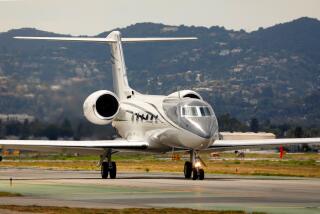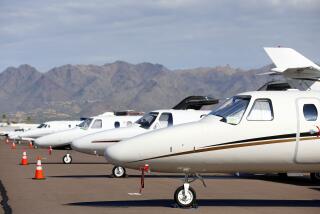Small Jets Need Tighter Scrutiny
- Share via
Unprecedented stress on the nation’s delay-plagued air travel system has led to vast changes in recent years, including a steep rise in the use of private corporate jets. As a result, the National Transportation Safety Board wisely suggests that corporate jets receive the same attention as large commercial airliners, particularly regarding inspections of aging aircraft.
The country has experienced an explosive increase in air travel with minimal increases in airport capacity. This year’s traffic is expected to reach 670 million passengers, a growth of about 20 million over 1999. President Clinton Thursday issued an executive order creating an office in the Federal Aviation Administration to focus on air traffic control and reduce flight delays. As a way around the big airport delays, many executives have turned to small jets, often flying out of regional airports.
Individuals and businesses increasingly share ownership of the craft, mainly Gulfstreams, Lears and Global Expresses. Such “fractional ownerships” rose from fewer than 250 in 1995 to nearly 1,700 last year. Other executives simply lease corporate jets as needed.
In the process, many first-generation corporate jets--some 25 years old or older--have been kept flying, which concerns the NTSB. The agency’s chairman, Jim Hall, wants the FAA to add smaller corporate jets to its aging-aircraft program, which requires more stringent inspection of the structural integrity of airliners.
The NTSB cited the widely publicized accident last year in which professional golfer Payne Stewart and five others died when a 25-year-old Learjet lost pressure in flight for reasons that remain a mystery. The agency’s reasoning seems sound. The shifts taking place in business travel demand more scrutiny of corporate jets.
More to Read
Inside the business of entertainment
The Wide Shot brings you news, analysis and insights on everything from streaming wars to production — and what it all means for the future.
You may occasionally receive promotional content from the Los Angeles Times.










